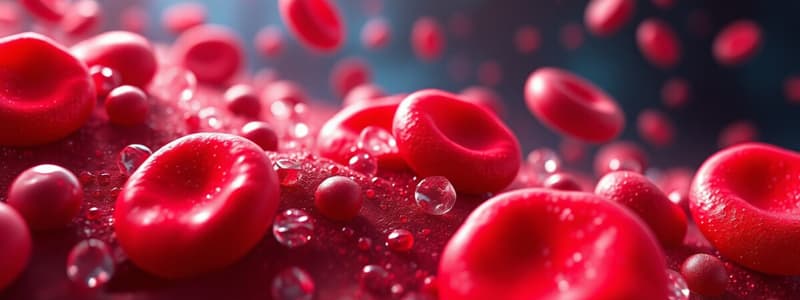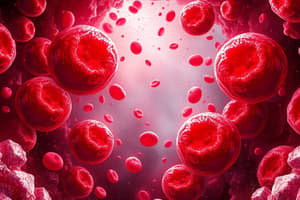Podcast
Questions and Answers
What are platelets primarily composed of?
What are platelets primarily composed of?
- Liquid plasma
- Antigens from red blood cells
- Whole cells
- Fragments of stem cells (correct)
Why can't platelets be seen in fresh blood?
Why can't platelets be seen in fresh blood?
- They disintegrate upon contact with air (correct)
- They are too large to visualize
- They flow too quickly
- They aggregate with red blood cells
Which blood type has both A and B antigens but no antibodies in the plasma?
Which blood type has both A and B antigens but no antibodies in the plasma?
- Type B
- Type O
- Type AB (correct)
- Type A
What do humans inherit from their parents that determines their blood type?
What do humans inherit from their parents that determines their blood type?
What is the significance of the Rh factor in blood types?
What is the significance of the Rh factor in blood types?
What combination of antibodies does a person with blood type O have?
What combination of antibodies does a person with blood type O have?
How many antigens are currently associated with the Rh blood group?
How many antigens are currently associated with the Rh blood group?
Which of the following represents a characteristic of blood group B?
Which of the following represents a characteristic of blood group B?
What is the blood type of a person who lacks the Rh factor?
What is the blood type of a person who lacks the Rh factor?
Which of the following statements about Rh+ and Rh- blood types is true?
Which of the following statements about Rh+ and Rh- blood types is true?
What occurs when incompatible blood types are mixed?
What occurs when incompatible blood types are mixed?
What is the primary purpose of the blood clotting process?
What is the primary purpose of the blood clotting process?
What substance is formed when thromboplastin reacts with calcium ions?
What substance is formed when thromboplastin reacts with calcium ions?
Which component helps catalyze the conversion of fibrinogen into fibrin during the clotting process?
Which component helps catalyze the conversion of fibrinogen into fibrin during the clotting process?
What role do fibrin threads play in the blood clotting process?
What role do fibrin threads play in the blood clotting process?
How quickly should blood clotting ideally occur after an injury?
How quickly should blood clotting ideally occur after an injury?
Which component of blood is primarily responsible for transporting oxygen?
Which component of blood is primarily responsible for transporting oxygen?
What percentage of blood is composed of plasma?
What percentage of blood is composed of plasma?
Which type of blood cell is primarily involved in fighting infections?
Which type of blood cell is primarily involved in fighting infections?
Which of the following correctly describes the structure of Red Blood Cells?
Which of the following correctly describes the structure of Red Blood Cells?
What are the two types of White Blood Cells based on the presence of granules?
What are the two types of White Blood Cells based on the presence of granules?
Where are the formed elements of blood manufactured?
Where are the formed elements of blood manufactured?
Which component of blood is responsible for forming clots?
Which component of blood is responsible for forming clots?
Which of the following is NOT a component of the blood?
Which of the following is NOT a component of the blood?
Flashcards are hidden until you start studying
Study Notes
Blood Composition
- Blood is the medium of circulation, transporting materials and fighting infections.
- It has two main parts: plasma (liquid) and corpuscles (formed elements).
Plasma
- Plasma is the liquid portion of blood, comprising 55% of its weight.
- It's mostly composed of water, blood proteins, and small amounts of inorganic materials.
Corpuscles
- Corpuscles make up the remaining 45% of the blood's weight.
- They are solid elements suspended in plasma, manufactured in the red bone marrow.
- Corpuscles include red blood cells (RBC), white blood cells (WBC), and blood platelets (thrombocytes).
Red Blood Cells (RBC)
- Transport gases, particularly oxygen, throughout the body.
- RBCs are biconcave disks without nuclei.
- Their red color comes from hemoglobin, which allows them to carry and transport oxygen.
White Blood Cells (WBC)
- Fight infections by secreting antibodies and engulfing foreign bodies (phagocytosis).
- WBCs have irregular shapes and contain nuclei.
- They are classified as granulocytes (with granules in their cytoplasm) and agranulocytes (lacking granules).
Blood Platelets (Thrombocytes)
- Are amorphous (irregular) in shape and not real cells, but fragments of stem cells in the red bone marrow.
- They disintegrate upon contact with air, initiating the blood clotting process.
ABO Blood Groups
- Austrian scientist Karl Landsteiner discovered four blood groups in 1900.
- Blood type A has antigen A on red blood cells and antibody B in the plasma.
- Blood type B has antigen B on red blood cells and antibody A in the plasma.
- Blood type AB has both antigens A and B on red blood cells and no A or B antibodies in the plasma.
- Blood type O has neither A nor B antigens on red blood cells but has both A and B antibodies in the plasma.
Antigens and Antibodies
- Antigens and antibodies are proteins that determine blood type.
- Individuals have different combinations of antigens and antibodies.
- Compatibility between antigens and antibodies is crucial.
- Blood type inheritance is determined by genetic factors from parents.
Rh Blood Type
- Rh (Rhesus) factor is the most significant blood group system, consisting of over 50 antigens.
- Rh-positive individuals possess the Rh factor, while Rh-negative individuals lack it.
- Rh-negative individuals can develop Rh antibodies after receiving Rh-positive blood.
- Individuals with Rh-positive blood can safely receive blood from Rh-negative individuals.
Blood Clumping (Agglutination)
- Mixing incompatible blood groups causes blood clumping (agglutination), which can be dangerous.
- Agglutinated blood clogs blood vessels, hindering blood circulation to various parts of the body.
The Blood Clotting Process
- The process involves thrombocytes, enzymes, minerals, and blood proteins in plasma.
- It prevents excessive bleeding caused by injury.
- Normal clotting time is within two minutes after injury.
Steps in the Blood Clotting Process
- Platelet disintegration converts thromboplastinogen into the enzyme thromboplastin.
- Thromboplastin and calcium ions convert prothrombin into thrombin.
- Thrombin catalyzes the conversion of soluble fibrinogen to insoluble fibrin threads.
- Fibrin threads form a network over the injured area, sealing it to prevent further bleeding.
- A red mass of connective tissue called a clot forms on top of the injured area.
Studying That Suits You
Use AI to generate personalized quizzes and flashcards to suit your learning preferences.




